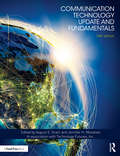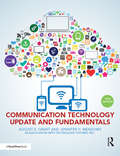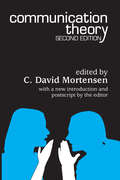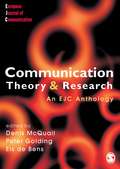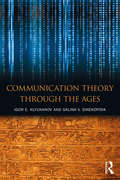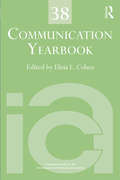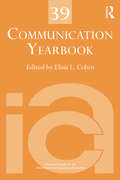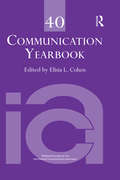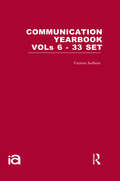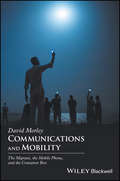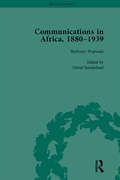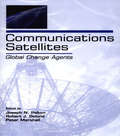- Table View
- List View
Communication Technology and Social Change: Theory and Implications (Routledge Communication Series)
by Carolyn A. Lin David J. AtkinCommunication Technology and Social Change is a distinctive collection that provides current theoretical, empirical, and legal analyses for a broader understanding of the dynamic influences of communication technology on social change. With a distinguished panel of contributors, the volume presents a systematic discussion of the role communication technology plays in shaping social, political, and economic influences in society within specific domains and settings. Its integrated focus expands and complements the scope of existing literature on this subject. Each chapter is organized around a specific structure, covering:*Background—offering an introduction of relevant communication technology that outlines its technical capabilities, diffusion, and uses; *Theory—featuring a discussion of relevant theories used to study the social impacts of the communication technology in question; *Empirical Findings—providing an analysis of recent academic and relevant practical work that explains the impact of the communication technology on social change; and*Social Change Implications—proposing a summary of the real world implications for social change that stems from synthesizing the relevant theories and empirical findings presented throughout the book. Communication Technology and Social Change will serve scholars, researchers, upper-division undergraduate students, and graduate students examining the relationship between communication and technology and its implications for society.
Communication Technology Update and Fundamentals: 16th Edition
by August E. Grant Jennifer H. MeadowsFor three decades, Communication Technology Update and Fundamentals has set the standard as the single best resource for students and professionals looking to brush up on how communication technologies have developed, grown, and converged, as well as what’s in store for the future. The secret to the longevity is simple—every two years, the book is completely rewritten to ensure that it contains the latest developments in mass media, computers, consumer electronics, networking, and telephony. Plus, the book includes the Fundamentals: the first five chapters explain the communication technology ecosystem, the history, structure, and regulations. The chapters are written by experts who provide snapshots of the state of each individual field. Together, these updates provide a broad overview of these industries, as well as the role communication technologies play in our everyday lives. In addition to substantial updates to each chapter, the 16th edition includes: First-ever chapters on Virtual/Augmented Reality and eSports. Updated user data in every chapter. Overview of industry structure, including recent and proposed mergers and acquisitions Suggestions on how to get a job working with the technologies discussed. The companion website, www.tfi.com/ctu, offers updated information on the technologies covered in this text, as well as links to other resources.
Communication Technology Update and Fundamentals: 15th Edition
by August E. Grant Jennifer H. MeadowsCommunication Technology Update and Fundamentals has set the standard as the single best resource for students and professionals looking to brush up on how communication technologies have developed, grown, and converged, as well as what’s in store for the future. The 15th edition is completely updated, reflecting the changes that have swept the communication industries. The first five chapters offer the communication technology fundamentals, including the ecosystem, the history, and structure—then delves into each of about two dozen technologies, including mass media, computers, consumer electronics, and networking technologies. Each chapter is written by experts who provide snapshots of the state of each individual field. Together, these updates provide a broad overview of these industries, as well as the role communication technologies play in our everyday lives. In addition to substantial updates to each chapter, the 15th edition includes: First-ever chapters on Big Data and the Internet of Things Updated user data in every chapter Projections of what each technology will become by 2031 Suggestions on how to get a job working with the technologies discussed The companion website, www.tfi.com/ctu, offers updated information on the technologies covered in this text, as well as links to other resources
Communication Technology Update and Fundamentals: 15th Edition
by August E. Grant Jennifer H. MeadowsCommunication Technology Update and Fundamentals has set the standard as the single best resource for students and professionals looking to brush up on how communication technologies have developed, grown, and converged, as well as what’s in store for the future. The 15th edition is completely updated, reflecting the changes that have swept the communication industries. The first five chapters offer the communication technology fundamentals, including the ecosystem, the history, and structure—then delves into each of about two dozen technologies, including mass media, computers, consumer electronics, and networking technologies. Each chapter is written by experts who provide snapshots of the state of each individual field. Together, these updates provide a broad overview of these industries, as well as the role communication technologies play in our everyday lives. In addition to substantial updates to each chapter, the 15th edition includes: First-ever chapters on Big Data and the Internet of Things Updated user data in every chapter Projections of what each technology will become by 2031 Suggestions on how to get a job working with the technologies discussed The companion website, www.tfi.com/ctu, offers updated information on the technologies covered in this text, as well as links to other resources
Communication Technology Update and Fundamentals: 16th Edition
by August E. Grant Jennifer H. MeadowsFor three decades, Communication Technology Update and Fundamentals has set the standard as the single best resource for students and professionals looking to brush up on how communication technologies have developed, grown, and converged, as well as what’s in store for the future. The secret to the longevity is simple—every two years, the book is completely rewritten to ensure that it contains the latest developments in mass media, computers, consumer electronics, networking, and telephony. Plus, the book includes the Fundamentals: the first five chapters explain the communication technology ecosystem, the history, structure, and regulations. The chapters are written by experts who provide snapshots of the state of each individual field. Together, these updates provide a broad overview of these industries, as well as the role communication technologies play in our everyday lives. In addition to substantial updates to each chapter, the 16th edition includes: First-ever chapters on Virtual/Augmented Reality and eSports. Updated user data in every chapter. Overview of industry structure, including recent and proposed mergers and acquisitions Suggestions on how to get a job working with the technologies discussed. The companion website, www.tfi.com/ctu, offers updated information on the technologies covered in this text, as well as links to other resources.
Communication Technology Update and Fundamentals: 17th Edition
by August E. Grant Jennifer H. MeadowsCommunication Technology Update and Fundamentals, now in its 17th edition, has set the standard as the single best resource for students and professionals looking to brush up on how communication technologies have developed, grown, and converged, as well as what’s in store for the future. The book covers the fundamentals of communication technology in five chapters that explain the communication technology ecosystem, its history, theories, structure, and regulations. Each chapter is written by experts who each provide a snapshot of an individual field. The book also dives into the latest developments in electronic mass media, computers, consumer electronics, networking, and telephony. Together, these updates provide a broad overview of these industries and examine the role communication technologies play in our everyday lives. In addition to substantial updates to each chapter, the 17th edition includes the first-ever chapter on Artificial Intelligence; updated user data in every chapter; an overview of industry structure, including recent and proposed mergers and acquisitions; and sidebars exploring sustainability and relevance of each technology to Gen Z. Communication Technology Update and Fundamentals continues to be the industry-leading resource for both students and professionals seeking to understand how communication technologies have developed and where they are headed.
Communication Technology Update and Fundamentals: 17th Edition
by August E. Grant Jennifer H. Meadows Technology Futures Inc.Communication Technology Update and Fundamentals, now in its 17th edition, has set the standard as the single best resource for students and professionals looking to brush up on how communication technologies have developed, grown, and converged, as well as what’s in store for the future. The book covers the fundamentals of communication technology in five chapters that explain the communication technology ecosystem, its history, theories, structure, and regulations. Each chapter is written by experts who each provide a snapshot of an individual field. The book also dives into the latest developments in electronic mass media, computers, consumer electronics, networking, and telephony. Together, these updates provide a broad overview of these industries and examine the role communication technologies play in our everyday lives. In addition to substantial updates to each chapter, the 17th edition includes the first-ever chapter on Artificial Intelligence; updated user data in every chapter; an overview of industry structure, including recent and proposed mergers and acquisitions; and sidebars exploring sustainability and relevance of each technology to Gen Z. Communication Technology Update and Fundamentals continues to be the industry-leading resource for both students and professionals seeking to understand how communication technologies have developed and where they are headed.
Communication Theory: Media, Technology and Society
by Dr David Holmes`This is a very clear and concise summary of media studies, present and future. There is no other book that can both be used as a teaching tool and can help scholars organize their thinking about new media as this book can' - Steve Jones, University of Chicago This book offers an introduction to communication theory that is appropriate to our post-broadcast, interactive, media environment. The author contrasts the `first media age' of broadcast with the `second media age' of interactivity. Communication Theory argues that the different kinds of communication dynamics found in cyberspace demand a reassessment of the methodologies used to explore media, as well as new understandings of the concepts of interaction and community (virtual communities and broadcast communities). The media are examined not simply in terms of content, but also in terms of medium and network forms. Holmes also explores the differences between analogue and digital cultures, and between cyberspace and virtual reality. The book serves both as an upper level textbook for New Media courses and a good general guide to understanding the sociological complexities of the modern communications environment.
Communication Theory
by C. David MortensenCommunication is the most complex and elevating achievement of human beings. Most people spend up to 70 percent of our waking hours engaged in some form of communication. Listening and responding to the messages of others occupies much of this time; the rest is taken up by talking, reading, and writing. An additional consideration is the rich assortment of nonverbal cues humans share, which also constitute a form of communication. All together, the stream of verbal and nonverbal information that bombards our senses is composed of as many as 2,000 distinguishable units of interaction in a single day. The kinds of interaction change constantly: morning greetings, cereal labels, bus signs, charts, traffic lights, hate stares, graffiti, coffee shop chat, gestures, laughter, and head nods: The themes are endless. All of this constitutes subject matter for the study of communication.The book seeks to acquaint students with a basic understanding of the process of human communication. The breadth and scope of subject matter is adaptable to a number of approaches to the first course in communication, whether theoretical, practical, contemporary, or traditional in orientation.The framework of this book introduces five topics of central interest to the field of communication theory. Part I describes the process of communication as it unfolds in face-to-face environments. Part II considers the symbolic significance of interpersonal behavior. Part III examines the organization of communicative acts and shows why human interactions tend to become more synchronous over time. Part IV explores the complex problem of understanding other people, demonstrating the tendency of understanding to become intersubjective. Part V accounts for the communicative significance of several basic human environments--communities, organizations, media, institutions, and culture.
Communication Theory
by C. David MortensenCommunication is the most complex and elevating achievement of human beings. Most people spend up to 70 percent of our waking hours engaged in some form of communication. Listening and responding to the messages of others occupies much of this time; the rest is taken up by talking, reading, and writing. An additional consideration is the rich assortment of nonverbal cues humans share, which also constitute a form of communication. All together, the stream of verbal and nonverbal information that bombards our senses is composed of as many as 2,000 distinguishable units of interaction in a single day. The kinds of interaction change constantly: morning greetings, cereal labels, bus signs, charts, traffic lights, hate stares, graffiti, coffee shop chat, gestures, laughter, and head nods: The themes are endless. All of this constitutes subject matter for the study of communication.The book seeks to acquaint students with a basic understanding of the process of human communication. The breadth and scope of subject matter is adaptable to a number of approaches to the first course in communication, whether theoretical, practical, contemporary, or traditional in orientation.The framework of this book introduces five topics of central interest to the field of communication theory. Part I describes the process of communication as it unfolds in face-to-face environments. Part II considers the symbolic significance of interpersonal behavior. Part III examines the organization of communicative acts and shows why human interactions tend to become more synchronous over time. Part IV explores the complex problem of understanding other people, demonstrating the tendency of understanding to become intersubjective. Part V accounts for the communicative significance of several basic human environments--communities, organizations, media, institutions, and culture.
Communication Theory and Research
by Denis Mcquail Peter Golding Prof Dr Els De BensThis exciting collection of papers represents some of the finest communications research published over the last decade. To mark the 20th anniversary of the European Journal of Communication, a leading international journal, the editors have selected 21 papers, all of which make significant and valuable interventions in the field of media and communications. The volume is prefaced with an introduction by the editors and will be a central research text for scholars in this field. European Journal of Communication
Communication Theory Through the Ages: A Journey Through the Ages
by Igor E Klyukanov Galina V SinekopovaCommunication Theory Through the Ages presents communication theory as a journey through history by way of asking engaged questions. Encouraging intellectual vitality, the authors show students step by step how theoretical ideas are interconnected and lead to an increasingly complex understanding of communication. Students will be motivated to ask questions as they encounter historical figures, social events, and artifacts, resulting in a richer understanding of the biographical, cultural, and social context for communication theories.
Communication Theory Through the Ages: A Journey Through the Ages
by Igor E Klyukanov Galina V SinekopovaCommunication Theory Through the Ages presents communication theory as a journey through history by way of asking engaged questions. Encouraging intellectual vitality, the authors show students step by step how theoretical ideas are interconnected and lead to an increasingly complex understanding of communication. Students will be motivated to ask questions as they encounter historical figures, social events, and artifacts, resulting in a richer understanding of the biographical, cultural, and social context for communication theories.
Communication Yearbook 38
by Elisia L. CohenCommunication Yearbook 38 continues the tradition of publishing state-of-the-discipline literature reviews and essays. Editor Elisia Cohen presents a volume that is highly international and interdisciplinary in scope, with authors and chapters representing the broad global interests of the International Communication Association. The contents include summaries of communication research programs that represent the most innovative work currently. Offering a blend of chapters emphasizing timely disciplinary concerns and enduring theoretical questions, this volume will be valuable to scholars throughout communication studies.
Communication Yearbook 38
by Elisia L. CohenCommunication Yearbook 38 continues the tradition of publishing state-of-the-discipline literature reviews and essays. Editor Elisia Cohen presents a volume that is highly international and interdisciplinary in scope, with authors and chapters representing the broad global interests of the International Communication Association. The contents include summaries of communication research programs that represent the most innovative work currently. Offering a blend of chapters emphasizing timely disciplinary concerns and enduring theoretical questions, this volume will be valuable to scholars throughout communication studies.
Communication Yearbook 39
by Elisia L. CohenCommunication Yearbook 39 continues the tradition of publishing state-of-the-discipline literature reviews and essays. Editor Elisia Cohen presents a volume that is highly international and interdisciplinary in scope, with authors and chapters representing the broad global interests of the International Communication Association. The contents include summaries of communication research programs that represent the most innovative work currently. Offering a blend of chapters emphasizing timely disciplinary concerns and enduring theoretical questions, this volume will be valuable to scholars throughout communication studies
Communication Yearbook 39
by Elisia L. CohenCommunication Yearbook 39 continues the tradition of publishing state-of-the-discipline literature reviews and essays. Editor Elisia Cohen presents a volume that is highly international and interdisciplinary in scope, with authors and chapters representing the broad global interests of the International Communication Association. The contents include summaries of communication research programs that represent the most innovative work currently. Offering a blend of chapters emphasizing timely disciplinary concerns and enduring theoretical questions, this volume will be valuable to scholars throughout communication studies
Communication Yearbook 40
by Elisia L. CohenCommunication Yearbook 40 completes four decades of publishing state-of-the-discipline literature reviews and essays. In the final Communication Yearbook volume, editor Elisia L. Cohen includes chapters representing international and interdisciplinary scholarship, demonstrating the broad global interests of the International Communication Association. The contents include summaries of communication research programs that represent the most innovative work currently. Emphasizing timely disciplinary concerns and enduring theoretical questions, this volume will be valuable to scholars throughout the communication discipline and beyond.
Communication Yearbook 40
by Elisia L. CohenCommunication Yearbook 40 completes four decades of publishing state-of-the-discipline literature reviews and essays. In the final Communication Yearbook volume, editor Elisia L. Cohen includes chapters representing international and interdisciplinary scholarship, demonstrating the broad global interests of the International Communication Association. The contents include summaries of communication research programs that represent the most innovative work currently. Emphasizing timely disciplinary concerns and enduring theoretical questions, this volume will be valuable to scholars throughout the communication discipline and beyond.
Communication Yearbooks Vols 6-33 Set
The Communication Yearbook annuals originally published between 1977 and 2009 publish diverse, state-of-the-discipline literature reviews that advance knowledge and understanding of communication systems, processes, and impacts across the discipline. Topics dealt with include Communication as Process, Research Methodology in Communication, Communication Effects, Taxonomy of Communication and European Communication Theory, Information Systems Division, Mass Communication Research, Mapping the Domain of Intercultural Communication, Public Relations, Feminist Scholarship, Communication Law and Policy, Visual Communication, Communication and Cross-Sex Friendships Across the Life Cycle, Television Programming and Sex Stereotyping, InterCultural Communication Training, Leadership and Relationships, Media Performance Assessment, Cognitive Approaches to Communication.
Communications and Mobility: The Migrant, the Mobile Phone, and the Container Box
by David MorleyCommunications and Mobility is a unique, interdisciplinary look at mobility, territory, communication, and transport in the 21st century with extended case studies of three icons of this era: the mobile phone, the migrant, and the container box. Urges scholars in media and communication to return to broader conceptions of the field that include mobility of all kinds—information, people, and commodities Embraces perspectives from media studies, science and technology studies, sociology, media anthropology, and cultural geography Discusses ideas of virtual and embodied mobility, network geographies, de-territorialization, sedentarism, nomadology, connectivity, containment, and exclusion Integrates the often-neglected transport studies into contemporary communication studies and theories of globalization
Communications and Mobility: The Migrant, the Mobile Phone, and the Container Box
by David MorleyCommunications and Mobility is a unique, interdisciplinary look at mobility, territory, communication, and transport in the 21st century with extended case studies of three icons of this era: the mobile phone, the migrant, and the container box. Urges scholars in media and communication to return to broader conceptions of the field that include mobility of all kinds—information, people, and commodities Embraces perspectives from media studies, science and technology studies, sociology, media anthropology, and cultural geography Discusses ideas of virtual and embodied mobility, network geographies, de-territorialization, sedentarism, nomadology, connectivity, containment, and exclusion Integrates the often-neglected transport studies into contemporary communication studies and theories of globalization
Communications in Africa, 1880–1939, Volume 1
by David SunderlandThis collection presents rare documents relating to the development of various forms of communication across Africa by the British, as part of their economic investment in Africa. Railways and waterways are examined.
Communications in Africa, 1880–1939, Volume 1: Railways: Operation And Economic Impact (Britain And Africa Ser.)
by David SunderlandThis collection presents rare documents relating to the development of various forms of communication across Africa by the British, as part of their economic investment in Africa. Railways and waterways are examined.
Communications Satellites: Global Change Agents (LEA Telecommunications Series)
by Joseph N. Pelton Robert J. Oslund Peter MarshallOver the past 40 years, satellites have played a key role in creating a global culture, spreading worldwide entertainment, stimulating technological interchange, and promoting trade around the world. Communications Satellites: Global Change Agents addresses communications satellites not only in terms of the technology and the services they provide, but also with consideration of the technology's impact in socio-political, security, economic, policy, news, entertainment, and cultural spheres.Editors Joseph N. Pelton, Robert J. Oslund, and Peter Marshall bring together contributions that place satellites into a broad context and examine how they influence and define today's world. Written in a non-technical, reader-friendly style, chapters investigate how satellite communications work and explore the role of satellites in such arenas as:*news and entertainment systems around the world;*Internet, E-business, and the new global economy;*global television and radio channels;*military operations; and*education, health services, economic development, and electronic immigration.Communications Satellites: Global Change Agents examines what satellites have been and projects how they will evolve in the future, articulating what they mean to the world today and forecasting what they will mean tomorrow. As the definitive source on communications satellites and their role in today's world, this volume serves as a valuable, unique, and timely resource for scholars and students in telecommunications, communication and technology, mass communication and society, and broadcasting.

